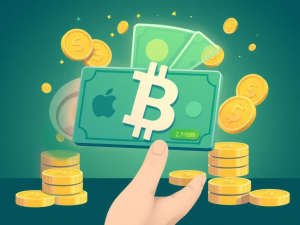
For seamless daily payments, consider utilizing cryptocurrency wallets as a reliable solution to manage your digital assets. These wallets allow you to store various cryptocurrencies securely, making transactions straightforward and efficient.
When engaging in everyday transactions, select a wallet that supports multiple currencies and integrates easily with payment platforms. This ensures quick exchange capabilities between different cryptocurrencies, enhancing your flexibility in managing expenses.
Prioritize security features such as two-factor authentication and backup options while choosing a wallet. A secure wallet not only protects your digital funds but also provides peace of mind during each transaction. By adopting these practices, you can confidently navigate the world of cryptocurrency payments.
Selecting the Right Wallet
Choose a digital wallet that aligns with your transaction needs. For daily payments, consider mobile wallets such as Trust Wallet or Coinbase Wallet, which facilitate easy access and management of cryptocurrency on-the-go.
If security is a priority, hardware wallets like Trezor or Ledger offer robust protection against online threats while still allowing for efficient transaction management. These devices store your private keys offline, minimizing exposure to risks associated with internet connectivity.
Evaluate the wallet’s compatibility with various cryptocurrencies. A multi-currency wallet can streamline transactions across different digital assets, making it easier to manage payments without needing to switch platforms frequently.
Check for user-friendly interfaces that simplify navigation and transaction execution. A wallet that provides clear visibility into your balance and transaction history enhances overall usability.
Consider the fees associated with transactions and exchanges within the wallet. Some wallets may impose high fees for certain types of transactions, which could impact your day-to-day financial activities.
Lastly, research community feedback regarding customer support and reliability. A responsive support system can be invaluable if you encounter issues managing your cryptocurrency transactions.
Making Payments with QR Codes
To streamline cryptocurrency transactions, utilize QR codes for quick and secure payments. Most wallets offer a built-in feature to generate and scan QR codes, simplifying the exchange process.
When receiving payments, generate a QR code within your wallet app that encodes your cryptocurrency address. Share this code with the sender; they can scan it to initiate the transaction without manually entering your wallet address, reducing errors.
For making payments, simply scan the merchant’s QR code using your wallet app. This action automatically populates the required details such as the amount and recipient's address, allowing you to confirm and execute the transaction swiftly.
Ensure your wallet is updated to support various cryptocurrencies, as some merchants accept multiple forms of digital currency. Before scanning or sharing any QR code, double-check that you are transacting with a trusted source to mitigate risks associated with fraud.
Manage transaction history within your wallet to track all payments made via QR codes. This feature is vital for maintaining accurate records and reconciling expenses when using cryptocurrency for daily purchases.
As you adopt this method for everyday transactions, be aware of network fees that may apply during exchanges. These fees vary depending on network congestion; therefore, keeping an eye on current rates can help optimize your spending strategy.
Tracking Your Transaction History
Utilizing a cryptocurrency wallet requires diligent management of your transaction history to ensure security and transparency. Follow these steps to effectively track your transactions:
- Access Wallet Features: Most wallets provide a built-in transaction history feature. Navigate to this section for an overview of all past transactions.
- Use Blockchain Explorers: For additional verification, use blockchain explorers corresponding to the cryptocurrency you own. Enter your wallet address to view all associated transactions publicly.
- Export Transaction Data: Many wallets allow you to export transaction records as CSV or PDF files. Use this functionality for offline storage or financial analysis.
Your transaction history is crucial for tax purposes and auditing personal finances. Keep the following in mind while managing it:
- Regular Monitoring: Check your transaction history frequently to identify any unauthorized activity or discrepancies.
- Secure Storage: Store important data securely, employing encrypted solutions if necessary, to protect sensitive information from breaches.
- Date and Amount Tracking: Record the date, amount, and recipient details for each transaction. This practice aids in maintaining accurate financial records.
If you engage in exchanges, monitor them closely since they can impact your overall portfolio value. By actively tracking your transactions, you maintain control over your cryptocurrency assets while ensuring their digital integrity.
Managing Security Settings
Regularly update your wallet software to protect against vulnerabilities. Ensure that you download updates directly from the official website or app store to avoid malicious versions.
Enable two-factor authentication (2FA) for an additional layer of security. This requires a second form of verification, such as a code sent to your mobile device, whenever you access your wallet or make transactions.
Store your private keys securely. Consider using hardware wallets for long-term storage, as they are less susceptible to online threats compared to software wallets.
Set strong and unique passwords for your wallet accounts. Avoid common phrases and include a mix of uppercase letters, lowercase letters, numbers, and special characters.
Be cautious with phishing attempts. Always verify URLs before entering sensitive information and use bookmarks for important sites like exchanges or wallets.
Regularly review your transaction history for any unauthorized activity. If you notice suspicious transactions, take immediate action by changing passwords and contacting support.
Limit access to your wallet. Only connect it to trusted devices and networks. Public Wi-Fi can expose you to risk; consider using a VPN for added security during transactions.
Educate yourself about potential scams in the cryptocurrency space. Awareness will help you recognize red flags associated with fraudulent schemes or offers that seem too good to be true.
Backup your wallet data frequently. Store backups in multiple secure locations, such as encrypted USB drives or cloud services with strong encryption measures.

You can be the first!